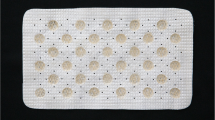Abstract
Background
Biomeshes made of porcine small intestine submucosa (SIS) have recently been suggested for repair of ventral hernia. A fully biodegradable combination of implant and fibrin sealant fixation was assessed in a new rat model with sutures serving as control.
Methods
In 10 Sprague–Dawley rats, two defects per animal were created in the abdominal wall left and right of the linea alba (1 cm in diameter), and the peritoneum was spared. The lesions were left untreated for 10 days to achieve a chronic condition and were then covered with SIS (2 × 2 cm), sealed or sutured (n = 10 per group). Randomization allowed sealant and sutures in one animal. Animals were killed on postoperative day 17, and implant sites were analyzed macroscopically, histologically, and microbiologically.
Results
Abscedation, encapsulation, and putrid seroma were observed in all samples, regardless of fixation technique. Histology revealed lytic necrosis and extensive inflammatory response of the surrounding tissue. Tissue samples obtained from three implant sites were positive for β-hemolytic Streptococcus. SIS was not detectable after 17 days.
Conclusions
Adverse effects were observed using SIS in an experimental model of ventral hernia and were not linked to fixation method or study design. Further experimental investigations on SIS are necessary before its clinical use in hernia repair.




Similar content being viewed by others
References
Campanelli G, Nicolosi FM, Pettinari D, Avesani EC (2004) Prosthetic repair, intestinal resection, and potentially contaminated areas: safe and feasible? Hernia 8: 190–192
Conze J, Rosch R, Klinge U, Weiss C, Anurov M, Titkowa S, Oettinger A, Schumpelick V (2004) Polypropylene in the intra-abdominal position: influence of pore size and surface area. Hernia 8: 365–372
Falagas ME, Kasiakou SK (2005) Mesh-related infections after hernia repair surgery. Clin Microbiol Infect 11: 3–8
Franklin ME Jr, Gonzalez JJ Jr, Glass JL (2004) Use of porcine small intestinal submucosa as a prosthetic device for laparoscopic repair of hernias in contaminated fields: 2-year follow-up. Hernia 8: 186–189
Helton WS, Fisichella PM, Berger R, Horgan S, Espat NJ, Abcarian H (2005) Short-term outcomes with small intestinal submucosa for ventral abdominal hernia. Arch Surg 140: 549–560
Hofbauer C, Andersen PV, Juul P, Qvist N (1998) Late mesh rejection as a complication to transabdominal preperitoneal laparoscopic hernia repair. Surg Endosc 12: 1164–1165
Jernigan TW, Croce MA, Cagiannos C, Shell DH, Handorf CR, Fabian TC (2004) Small intestinal submucosa for vascular reconstruction in the presence of gastrointestinal contamination. Ann Surg 239: 733–738
Katkhouda N, Mavor E, Friedlander MH, Mason RJ, Kiyabu M, Grant SW, Achanta K, Kirkman EL, Narayanan K, Essani R (2001) Use of fibrin sealant for prosthetic mesh fixation in laparoscopic extraperitoneal inguinal hernia repair. Ann Surg 233: 18–25
Klinge U, Klosterhalfen B, Birkenhauer V, Junge K, Conze J, Schumpelick V (2002) Impact of polymer pore size on the interface scar formation in a rat model. J Surg Res 103: 208–214
Kumar S, Wilson RG, Nixon SJ, Macintyre IM (2002) Chronic pain after laparoscopic and open mesh repair of groin hernia. Br J Surg 89: 1476–1479
Ladurner R, Mussack T (2004) Small bowel perforation due to protruding spiral tackers: a rare complication in laparoscopic incisional hernia repair. Surg Endosc 18: 1001
McCormack K, Scott NW, Go PM, Ross S, Grant AM (2003) Laparoscopic techniques versus open techniques for inguinal hernia repair. Cochrane Database Syst Rev CD001785
McCready RA, Hodde J, Irwin RJ, Coffey AC, Divelbiss JL, Bryant MA, Chitwood RW, Paget DS, Chess BA (2005) Pseudoaneurysm formation in a subset of patients with small intestinal submucosa biologic patches after carotid endarterectomy. J Vasc Surg 41: 782–788
McGreevy JM, Goodney PP, Birkmeyer CM, Finlayson SR, Laycock WS, Birkmeyer JD (2003) A prospective study comparing the complication rates between laparoscopic and open ventral hernia repairs. Surg Endosc 17: 1778–1780
Moon V, Chaudry GA, Choy C, Ferzli GS (2004) Mesh infection in the era of laparoscopy. J Laparoendosc Adv Surg Tech A 14: 349–352
Neumayer L, Giobbie-Hurder A, Jonasson O, Fitzgibbons R Jr, Dunlop D, Gibbs J, Reda D, Henderson W (2004) Open mesh versus laparoscopic mesh repair of inguinal hernia. N Engl J Med 350: 1819–1827
O’Dwyer PJ, Kingsnorth AN, Molloy RG, Small PK, Lammers B, Horeyseck G (2005) Randomized clinical trial assessing impact of a lightweight or heavyweight mesh on chronic pain after inguinal hernia repair. Br J Surg 92: 166–170
Paajanen H (2002) Do absorbable mesh sutures cause less chronic pain than nonabsorbable sutures after Lichtenstein inguinal herniorraphy? Hernia 6: 26–28
Petter-Puchner A, Fortelny R, Mittermayr R, Öhlinger W, Redl H (2005) Fibrin sealing versus stapling of hernia meshes in an onlay model in the rat. Hernia 9: 322–329
Poulose BK, Scholz S, Moore DE, Schmidt CR, Grogan EL, Lao OB, Nanney L, Davidson J, Holzman MD (2005) Physiologic properties of small intestine submucosa. J Surg Res 123: 262–267
Raghavan D, Kropp BP, Lin HK, Zhang Y, Cowan R, Madihally SV (2005) Physical characteristics of small intestinal submucosa scaffolds are location-dependent. J Biomed Mater Res A 73A: 90–96
Topart P, Vandenbroucke F, Lozach P (2005) Tisseel versus tack staples as mesh fixation in totally extraperitoneal laparoscopic repair of groin hernias: a retrospective analysis. Surg Endosc 19: 724–727
Winslow ER, Quasebarth M, Brunt LM (2004) Perioperative outcomes and complications of open vs laparoscopic extraperitoneal inguinal hernia repair in a mature surgical practice. Surg Endosc 18: 221–227
Author information
Authors and Affiliations
Corresponding author
Rights and permissions
About this article
Cite this article
Petter-Puchner, A.H., Fortelny, R.H., Mittermayr, R. et al. Adverse effects of porcine small intestine submucosa implants in experimental ventral hernia repair. Surg Endosc 20, 942–946 (2006). https://doi.org/10.1007/s00464-005-0568-9
Received:
Accepted:
Published:
Issue Date:
DOI: https://doi.org/10.1007/s00464-005-0568-9




